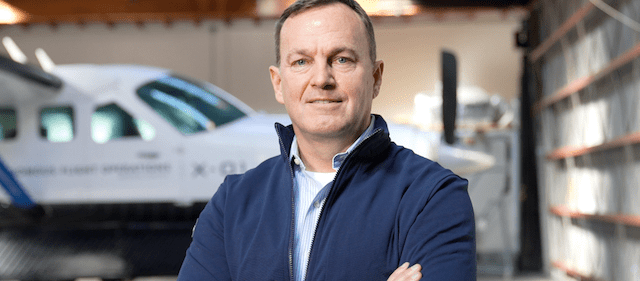
Fred Cromer, former president of Bombardier’s commercial aircraft division, has taken on a new role as chief financial officer of Xwing. (Xwing)
Fred Cromer, former president of Bombardier Commercial Aircraft, has worked in several challenging roles across different segments of aviation and will be taking on another exciting challenge in his new role as chief financial officer (CFO) of Xwing, the California-based startup developing a new software capable of enabling autonomous gate-to-gate flight on commercial cargo aircraft.
During a recent interview with Avionics International, Cromer said that the company’s focus on cargo-carrying aircraft could make its entry point into actual commercial flight operations a reality faster than if they were focusing on passenger-carrying jets. Xwing’s Nov. 18 announcement of the addition to Cromer to their executive team cites a United Nations Conference on Trade and Development report that estimates global e-commerce sales jumped to $26.7 trillion, driving the need for increased air cargo operations.
Cromer and the rest of the Xwing team believe that the autonomous software stack they’re developing could be ready for retrofitting to cargo carrying aircraft in the near future—although they have not committed to a timeline for achieving supplemental type certification (STC) from the Federal Aviation Administration (FAA) yet.
“The more that I learned about what Xwing was doing, particularly in autonomous flight and developing software to make that a reality for existing aircraft, I thought that was a really interesting strategic path that is different than what others might be doing out there. And then particularly in the regional cargo business where that could provide potentially a faster path to certification. I thought it was a great, a very pragmatic approach to introducing this kind of advanced technology, and jumped at the opportunity to join their team,” Cromer said.
Xwing’s software stack and mission control center completed what the company claims is the world’s first fully autonomous gate-to-gate flight of a commercial cargo aircraft, a Cessna Grand Caravan 208B, during a February 2021 flight remotely controlled from their mission control center in Concord, California. In order to enable autonomous flight on existing aircraft, Xwing is developing an automated flight control system to control all flight control surfaces including the aileron, elevator, rudder, flaps, nose wheel, differential brakes, and flaps. The company’s complete system also includes a perception software stack to provide obstacle detection and avoidance that can be coupled with the flight control system.
Along with his most recent role at Bombardier, Cromer’s experience in the aviation industry includes other experience serving as the president of International Lease Finance Corporation and as CFRO of regional carriers ExpressJet Holdings and Continental Express.
His appointment as Xwing’s new CFO arrives on the heels of the company’s addition of Jesse Kallman as Vice President of Commercialization and Strategy and addition of key advisors, comprising of Greg Hall, former CEO of Global Air Operations at FedEx; Jeff Martin, former COO at WestAir; and Allan McArtor, Chairman and CEO of Airbus Americas.

Xwing has been testing its modified Cessna Grand Caravan pictured here at its facility in California, in preparation for eventually seeking an FAA STC to retrofit their autonomous software stack to commercial cargo aircraft. (Xwing)
This year, the company has also announced a $40 million funding round and a $400 million valuation. In October, Xwing also established a key supplier partnership with Inmarsat, the U.K.-based satellite operator that will be providing its Velaris unmanned aircraft terminal to enable connectivity as part of the overall Xwing autonomous flight retrofit package.
The company that manufactures the Cessna Grand Caravan that Xwing has been testing its autonomous software on, Textron, also has become a development partner under a non-disclosure agreement announced Oct. 12. The agreement does not specify how Textron and Xwing might jointly market converted and new-build autonomous aircraft; however, Xwing has acknowledged that the partners are discussing next steps.
“We’re seeing the cargo industry going through a phase of explosive growth. How will the existing players in this sector keep up with demand going forward? One of the constraints is being able to find and hire qualified pilots. So this autonomous path actually is a way to do some amazing things in terms of being able to get better efficiency and better productivity out of the aircraft and removing a potential constraint of growth in the future,” Cromer said. “So it is sort of an evolution that’s been coming. Many people in the aviation industry have been thinking about this for quite some time. If you think about it, the more modern commercial aircraft that are produced today, they’re almost 95% automated in the existing technology that they feature. Taking that one step further to make it completely autonomous really just opens up new opportunities.”
Xwing’s current research and development focus centers around operating a converted Caravan under an experimental certificate with a supervising pilot on board. In addition, it has commercial operations with Caravans through its Part 135 subsidiary San Antonio Air Charter. It has applied to the FAA for clearance to fly its experimental aircraft commercially with a ground-based pilot and safety pilot on board, and this approval is still in process.
Cromer said his initial focus will be on helping Xwing acquire additional capital and investment to support the continued development of their autonomous software stack.
“The financial needs of the company will continue to evolve as we continue to develop and refine our technology. We will need additional capital for our efforts and expansion. Staying ahead of that with a little bit more development of our financial models as we go forward will be a good tool with us to make sure that that we’re funding our needs in a timely basis,” Cromer said. “The investor interest is there; now it’s about taking some of that investor enthusiasm for where we’re going as a company and bringing that financial function along so that we enable growth. That’s key for a company like Xwing and the stage that we’re in at the moment.”